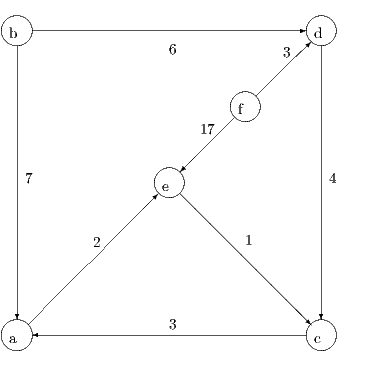
satisfying all of the following conditions:
- {x ∈ IRn : Hx = h,x ≥ 0} is bounded
- (D) has a unique optimal solution (y*,u*)
- A and H each have one row
- every optimal basic feasible solution to the Lagrangian subproblem

violates Ax = b.
Let

Is 0 a subgradient of Θ(y*)?

One unit of commodity A must be shipped from b to c and one unit of commodity B must be shipped from f to e. The cost of shipping one unit of flow along an arc is indicated in the figure. The cost is the same for each commodity. Each arc e ∈ E in the graph has capacity equal to one; this is the maximum total flow along the arc for the combination of the two commodities. Used the path-based formulation to find the minimum cost total flow. What is the optimal integral flow?

where e denotes the vector of ones. Since the number of possible tours is very large, a column generation approach is used.
Let n = 4. No tour is allowed to visit more than three cities (plus the base city). Assume the cost ct of a tour is given by the sum of the edge lengths in the tour, and the edge lengths are as follows:
| city | 0 | 1 | 2 | 3 | 4 |
| 0 | – | 4 | 7 | 9 | 4 |
| 1 | 4 | – | 4 | 6 | 8 |
| 2 | 7 | 4 | – | 7 | 5 |
| 3 | 9 | 6 | 7 | – | 7 |
| 4 | 4 | 8 | 5 | 7 | – |
Assume we have 2 initial tours:

and an initial primal solution with xt = 1 for each of the two tours. One optimal dual solution for this set of tours is = (6,9,13,7)T. Find at least 4 additional valid tours for which the corresponding dual constraint for (CP) is violated.

where g,h ∈ IRn are nonnegative vectors of parameters. How does this change the dual problem? What benefit do you think this might have?